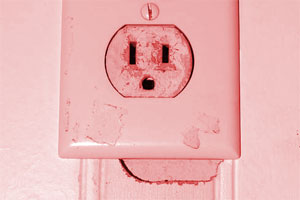 Before You Invest in Photovoltaics, make sure your house isn't haunted by phantom loads.Some Devices Suck Power While They Sleep
Before You Invest in Photovoltaics, make sure your house isn't haunted by phantom loads.Some Devices Suck Power While They Sleep
When writing about energy efficiency in California, I know that emphasizing heating systems doesn’t carry much punch. I might as well try to get Californians interested in who makes the best deep- dish pizza. (That’s Chicago, of course. Zachary’s isn’t bad though.) Cooling systems are accounting for more and more of a share of residential energy use as we continue to build out from the cities near the Bay in hot dry climates. But overall, when it comes to climate, the inside and the outside of Bay Area homes are pretty much the same for most of the year. But let’s not get soft on energy efficiency! There are other energy users in California homes that threaten to lift us in the future to the level of, say, what a Wisconsin home uses in the winter today.
Miscellaneous electric loads are electric loads other than heating and cooling, water heating, refrigerators, and lighting, and include consumer electronics, outdoor lights, and portable inside lighting fixtures. The U.S. Department of Energy’s Energy Information Agency estimates that these “other” electric loads, along with televisions and office equipment, made up close to 30% of U.S. residential electricity consumption in 2006; this will rise to about 35% by 2020. Part of the reason for the growth in energy use of these devices as a percentage of total home energy use is that homes are heating and cooling more efficiently, with better HVAC equipment, tighter building envelopes, and more insulation.
Rich Brown and Greg Homan of Lawrence Berkeley National Laboratory, measured electricity use in 13 new California homes in 2007 and came up with some interesting results. They metered plug-in devices in standby, off, or low-power mode. Since the homes were not yet occupied, they estimated the annual energy use by using typical use patterns and the energy use of the plug-in devices in active mode, or “on,” measured in other studies. Some of the homes were model homes and packed with appliances and electronics like TVs, and others had only the plug-in devices installed by the builders. Builder installed devices include things like garage door openers, structured wiring, and gas fireplaces. The homes were in four different subdivisions and span the range of typical new construction to super efficient homes with PhotoVoltaic (PV) systems installed.
The builder-installed devices use on average 800 kilowatt-hours (kWh) of electricity per year, or about $80 worth with electricity at a low $0.10 per kWh. That does not include lighting energy. That’s interesting. About half of the energy used by the builder-installed devices is used by devices that are supposed to be turned off, or are in standby mode! That’s very interesting. This is like having a 50-Watt light bulb on 24 hours a day, 365 days a year, lighting nothing.
